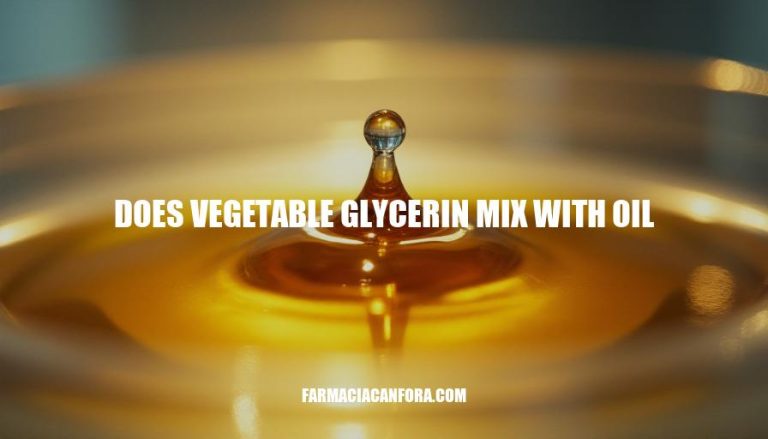


Vegetable glycerin, also known as glycerol, is a clear, odorless, and sweet-tasting liquid derived from plant oils like coconut, soy, and palm. The question “Does vegetable glycerin mix with oil?” is relevant because understanding the compatibility of these substances is crucial in industries like cosmetics, food, and pharmaceuticals. Knowing how they interact can affect product formulation, stability, and effectiveness.
Vegetable glycerin, or glycerol, is a simple polyol compound with the chemical formula
. Its structure consists of three carbon atoms, each bonded to a hydroxyl group (OH), making it highly hydrophilic and capable of forming hydrogen bonds.
Solubility: Glycerin is completely soluble in water and alcohols but insoluble in hydrocarbons and fatty oils. This solubility profile means it doesn’t mix well with oils, as oils are typically non-polar and glycerin is polar.
Common Uses: Vegetable glycerin is widely used in the food, cosmetics, and pharmaceutical industries. It acts as a humectant, sweetener, and solvent in food products, helps in moisturizing and preserving cosmetics, and serves as a lubricant and humectant in pharmaceuticals.
Properties of Oils Relevant to Mixing with Vegetable Glycerin:
Polarity:
Types of Oils Commonly Used:
Chemical Characteristics:
Emulsification:
Vegetable glycerin, also known as glycerol, is a clear, odorless liquid derived from plant oils. It is a humectant, meaning it attracts water, and is commonly used in skincare and beauty products for its moisturizing properties. However, when it comes to mixing with oils, vegetable glycerin does not naturally mix well with them.
Polarity: The primary reason vegetable glycerin and oils do not mix well is due to their differing polarities. Glycerin is a polar molecule, meaning it has a positive and negative end, similar to water. Oils, on the other hand, are non-polar molecules. Polar and non-polar substances generally do not mix because their molecules do not attract each other.
Emulsification: To achieve a stable mixture of glycerin and oil, an emulsifier is needed. Emulsifiers are substances that have both a hydrophilic (water-attracting) end and a lipophilic (oil-attracting) end. They help to stabilize the mixture by reducing the surface tension between the polar and non-polar substances, allowing them to mix more uniformly.
Use of Emulsifiers: Common emulsifiers include lecithin, polysorbates, and certain natural gums like xanthan gum. These emulsifiers can help create a stable emulsion by binding the glycerin and oil together.
Proper Ratios: The ratio of glycerin to oil and emulsifier is crucial. A common starting point is to use 3 parts glycerin to 1 part oil, with the emulsifier added according to the manufacturer’s instructions.
Mixing Techniques:
Stabilization: Once mixed, the emulsion should be allowed to cool and stabilize. This can take several hours, and the mixture should be periodically stirred to ensure uniformity.
In practical terms, if you want to mix vegetable glycerin with oil for a skincare product, you would:
By following these steps, you can create a stable mixture of vegetable glycerin and oil that can be used in various cosmetic and skincare formulations.
Mixing vegetable glycerin with oil offers numerous practical applications and benefits across various industries:
This versatile combination is a game-changer in multiple fields, offering enhanced performance and user benefits.
Mixing vegetable glycerin with oil can present several challenges. Here are some potential issues and solutions:
Separation: Vegetable glycerin is water-soluble, while oils are not, leading to separation.
Viscosity Differences: Glycerin is thick and syrupy, which can make it difficult to mix evenly with oils.
Skin Irritation: Some oils can cause skin irritation when mixed with glycerin.
Allergic Reactions: Both glycerin and certain oils can cause allergic reactions in some individuals.
Storage Issues: The mixture can degrade over time, especially if not stored properly.
Incompatibility with Essential Oils: Some essential oils may not mix well with glycerin.
By following these best practices, you can effectively address the challenges of mixing vegetable glycerin with oil.
Vegetable glycerin can be mixed with oil, creating a stable mixture that offers numerous benefits across various industries, including skincare, cosmetics, food, pharmaceuticals, and aromatherapy. The combination enhances moisturization, improves absorption, and soothes skin irritations in skincare applications. In cosmetics, it helps emulsify oil and water-based ingredients, extends shelf life, and adds a silky texture to products.
However, mixing vegetable glycerin with oil can present challenges such as separation, viscosity differences, skin irritation, allergic reactions, storage issues, and incompatibility with essential oils. To overcome these issues, using an emulsifier like lecithin or polysorbate 20, warming the mixture before blending, conducting patch tests, storing the mixture properly, and diluting essential oils can be effective solutions.
The implications of mixing vegetable glycerin with oil are significant, offering enhanced performance and user benefits in various applications. By understanding the potential challenges and implementing best practices, individuals can effectively create a stable mixture that unlocks the full potential of this versatile combination.